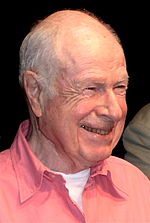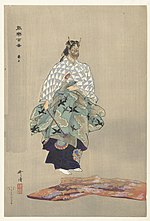Zeami Motokiyo (世阿弥 元清) (c. 1363 – c. 1443), also called Kanze Motokiyo (観世 元清), was a Japanese aesthetician, actor, and playwright. His father, Kan'ami...
19 KB (2,455 words) - 23:11, 20 July 2024
been performed since the 14th century. Developed by Kan'ami and his son Zeami, it is the oldest major theater art that is still regularly performed today...
61 KB (7,144 words) - 11:26, 18 August 2024
Zeami is a crater on Mercury. Its name was adopted by the International Astronomical Union in 1976, after the Japanese dramatist and playwright Zeami...
2 KB (100 words) - 21:25, 18 March 2022
adapted, and thoroughly analysed and discussed by the great Noh playwright Zeami, who viewed it as a universal concept applying to the patterns of movement...
4 KB (579 words) - 21:29, 25 April 2024
the original on January 18, 2021. Retrieved September 11, 2022. Zeami (2008). Zeami, performance notes. Translated by Hare, Tom. New York: Columbia University...
19 KB (1,602 words) - 13:11, 27 August 2024
(1358–1408), the shōgun of Japan, he implored Zeami to have a court education for his arts. After Zeami succeeded his father, he continued to perform...
37 KB (4,536 words) - 10:12, 5 September 2024
Retrieved 2007-04-01. Zeami. "Teachings on Style and the Flower (Fūshikaden)." from Rimer & Yamazaki. On the Art of the Nō Drama. p20. "Zeami and the Transition...
19 KB (2,253 words) - 14:15, 4 September 2024
in The Way of Tea, "Sado 茶道". Fuhaku based his process from the works of Zeami Motokiyo, the master of Noh, which then became a part of the philosophy...
6 KB (720 words) - 17:25, 15 July 2024
Dramatic theory (section Zeami Motokiyo)
Renaissance theatre and Jesuit drama, leading to the 17th-century French drama. Zeami Motokiyo (c. 1363–1443) was a Japanese actor and author. He wrote several...
26 KB (3,525 words) - 10:21, 17 February 2024
Kanze Kiyotsugu (観世 清次). He is the father of the well-known playwright Zeami Motokiyo (世阿弥 元清). Kan'ami's career began in Obata, Nabari-shi, Mie when...
2 KB (206 words) - 11:38, 4 October 2022
the will of Richard Whittington. 1434 – Japanese Noh actor and playwright Zeami Motokiyo is exiled to Sado Island by the Shōgun. 1438: 28 April – Completion...
42 KB (4,805 words) - 01:53, 5 September 2024
in the union of the sarugaku, with music and dance made by Kan'ami and Zeami Motokiyo. Among the characteristic aspects of it are the masks, costumes...
74 KB (7,796 words) - 04:45, 20 August 2024
for the culmination of the tournament echoes the words of the playwright Zeami to represent the excitement of the decisive bouts and the celebration of...
72 KB (8,057 words) - 22:03, 1 September 2024
Artaud, Edward Gordon Craig, Charles Dullin, Vsevolod Meyerhold and Motokiyo Zeami. 1946: Love's Labour's Lost (Shakespeare Memorial Theatre) 1947: Romeo and...
52 KB (4,534 words) - 16:59, 29 July 2024
many Noh plays based on The Tale of Genji. It is sometimes attributed to Zeami Motokiyo or to his son-in-law Zenchiku; the extant version of the text is...
5 KB (549 words) - 17:22, 22 May 2024
ancestors by Zeami Motokiyo, the premiere Noh playwright in history, who attributed the origins of Noh to Hata no Kawakatsu. According to Zeami's writings...
12 KB (1,374 words) - 00:46, 27 August 2024
actor of Noh theatre. He was the eldest son of famed playwright and actor Zeami Motokiyo. Motomasa succeeded as head of the Kanze troupe when his father...
4 KB (490 words) - 15:25, 3 April 2023
Archbishop of Prague, writer, composer and poet (died 1400) c. 1363 – Zeami Motokiyo (世阿弥 元清), Japanese Noh actor and playwright (died c. 1443) 1364...
23 KB (2,715 words) - 03:40, 31 August 2024
Atsumori (敦盛, Atsumori) is a Japanese Noh play by Zeami Motokiyo which focuses on Taira no Atsumori, a young samurai who was killed in the Genpei War...
6 KB (685 words) - 15:47, 19 October 2023
Yugao is a Noh play, sometimes attributed to Zeami, based on the story of Yūgao (Lady Moonflower) from the Tale of Genji. A travelling priest is drawn...
1 KB (214 words) - 10:57, 30 July 2022
quickly. The concept, elaborated on at length by master Noh playwright Zeami, governs not only the actions of the actors, but also the structure of the...
61 KB (6,843 words) - 18:25, 27 July 2024
Kan'ami, revised by Zeami Motokiyo. One of the most highly regarded of Noh plays, it is mentioned more than any other in Zeami's own writings, and is...
6 KB (767 words) - 10:01, 1 August 2022
is also used in traditional Japanese Noh drama, particularly by Zeami Motokiyo. Zeami, in his work Sandō (The Three Paths), originally described a five-part...
11 KB (1,370 words) - 19:50, 26 October 2023
works on Noh, Nōgaku, and medieval Japan. Utage no shintai: Basara kara Zeami e (宴の身体 バサラから世阿弥へ), Iwanami Shoten、1991 Nō: Chūsei kara no hibiki (能 中世からの響き)...
4 KB (368 words) - 09:21, 26 August 2024
4 unknown, rev. Zeami Arashiyama 嵐山 1 Komparu Zenpō Aridōshi 蟻通 4 Zeami Asagao 朝顔(槿) ? ??? Ashikari The Reed Cutter 芦刈 or 葦刈 4 Zeami Asukagawa Asuka River...
21 KB (120 words) - 08:21, 30 October 2023
Salieri in Amadeus, Kitagawa Utamaro in the musical Utamaro, and Zeami Motokiyo in Musical Zeami. Whirlwind (1964) – Jūbei Nichiren (1979) – Hōjō Tokiyori Final...
6 KB (540 words) - 18:02, 4 May 2024
is a frequently-performed Noh play of the fifth category attributed to Zeami Motokiyo. Its central character is the legendary mountain hag, Yama-uba...
2 KB (274 words) - 14:06, 18 April 2024
no Ki (The Potted Trees) is also the title of a circa 1383 noh play by Zeami Motokiyo, based on a story about an impoverished samurai who burns his last...
62 KB (7,197 words) - 21:54, 4 September 2024
Noh play by an unknown author, written in the 15th century. The fact that Zeami wrote a revised version of the play, called Koi no omoni ("Love's Heavy...
3 KB (332 words) - 22:41, 11 August 2021
Saigyōzakura (西行桜, Saigyō's cherry tree) is a Noh play by Zeami about the famous poet Saigyō, regarding his well-known love for cherry blossoms. Saigyō...
2 KB (266 words) - 18:27, 8 October 2021

















